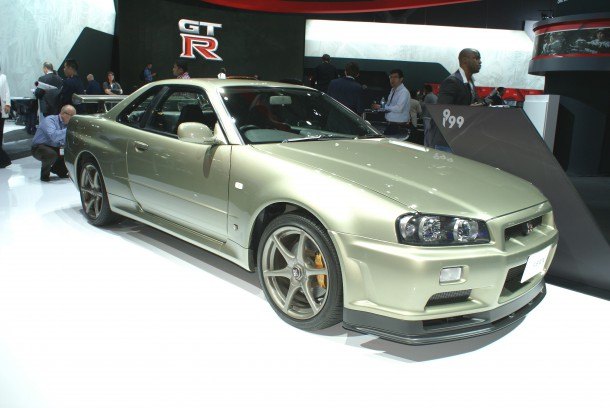NYIAS: The Evolution of GT-R Shown Within One Thousand Square Feet

The newly refreshed 2017 Nissan GT-R on the rostrum drew the focus of many, but it was the five historic vehicles Nissan decided to bring to the New York International Auto Show that shouted for my attention in the crowd.
These five Skylines represent the race-bred heritage of the GT-R, while simultaneously taunting American enthusiasts who could never buy these iconic sports cars when they arrived new to dealerships.
I spoke with NISMO Chief Product Specialist Hiroshi Tamura and asked him what drew him to the GT-R.
“Ten-year-old Hiroshi goes to Fuji Speedway with his older cousin who owned a car. I wanted a Nissan GT-R someday. Unfortunately, for the next thirteen years, I had no GT-R,” Hiroshi said.
He went to work for Nissan, and eventually worked on several GT-R programs including the R34, often known as Godzilla.
The R34 Skyline GT-R shown here today is the M-spec Nur model, a limited edition built for endurance racing. The gold-painted valve cover signifies the N1 spec RB26 twin-turbo engine, still nominally rated at 276 horsepower under the Japanese auto industry’s handshake agreement to not advertise more powerful engines. Anyone who spent any time with Sony’s Gran Turismo knows that there is plenty more beneath that long hood.
The R34 evolved from this 1995 R33 GT-R, famous for lapping the Nurburgring Nordschleife in just under eight minutes. The R33 was itself evolved from 1989’s R32 GT-R, a revolution at the time in Japanese performance car scene. A powerful twin-turbo, twin-cam inline six-cylinder engine motivated all four wheels of these GT-Rs by way of Nissan’s ATTESA E-TS torque-vectoring all-wheel-drive system.
These high-tech marvels were a vast departure from the original GT-R. While the racing histories of all five Skyline GT-R generations are dominant, the earliest cars were a bit more traditional in design.
The 1973 Skyline GT-R shown here — known alternatively by the C110 chassis code or the “Kenmeri” nickname after a commercial featuring the car and a young couple named Ken and Mary — is one of 197 produced before new emissions regulations cut off production of the high-performance coupé.
The car that started the legend of the GT-R is the last on our trip down memory lane. The C10 chassis, known as Hakosuka by fans, launched in 1969. Tamura tells me “Hako means ‘box’, suka is short for ‘Skyline,'” which is quite clear after comparing it to the later generations.
2.0-liter six-cylinder engines powered both the Hakosuka and Kenmeri, and were quite advanced for the time with twin cams and four valves per cylinder. These advanced engines produced 160 hp and would rev to 7,000 rpm, making these dominant in Japanese touring car events.
Tamura further emphasized the significance of the four round (usually) taillights as a thread connecting the Skyline generations. He referred to them as “four red doughnuts.”

Some enthusiasts say they were born with gasoline in their veins. Chris Tonn, on the other hand, had rust flakes in his eyes nearly since birth. Living in salty Ohio and being hopelessly addicted to vintage British and Japanese steel will do that to you. His work has appeared in eBay Motors, Hagerty, The Truth About Cars, Reader's Digest, AutoGuide, Family Handyman, and Jalopnik. He is a member of the Midwest Automotive Media Association, and he's currently looking for the safety glasses he just set down somewhere.
More by Chris Tonn
Latest Car Reviews
Read moreLatest Product Reviews
Read moreRecent Comments
- Carguy949 You point out that Rivian and Tesla lack hybrids to “bring home the bacon”, but I would clarify that Tesla currently makes a profit while Rivian doesn’t.
- Cprescott I'm sure this won't matter to the millions of deceived Honduh owners who think the company that once prided itself on quality has somehow slipped in the real world. Same for Toyoduhs. Resting on our Laurel's - Oh, what a feeling!
- Jrhurren I had this happen numerous times with my former Accord. It usually occurred when on a slow right curve in the road. Somehow the system would get confused and think the opposite lane (oncoming traffic) was an impending head-on collision.
- Cprescott The Ford Shamaro is ugly, thick bodied, and a Mustang pretender.
- Analoggrotto Speaking of mud, does anyone here enjoy naked mud wrestling?







































Comments
Join the conversation
Someone line up baby seals for me to club to get that '73, it's freaking boss.
Previous generations had nice, clean and simple classic 2-door design , this new one is a different, more muscular("bulky") approach - it's got "interesting" side and rear view, but "the face" of this car is rather blunt and lacks personality .. BTW> After all this car needs new replacement, not refresh ..